Reverse Chronological Resume Templates
Reverse Chronological Resume Templates
If you’ve ever written a resume before, you may already know about the reverse chronological resume format. But what does a reverse chronological resume actually involve? Let's explore.
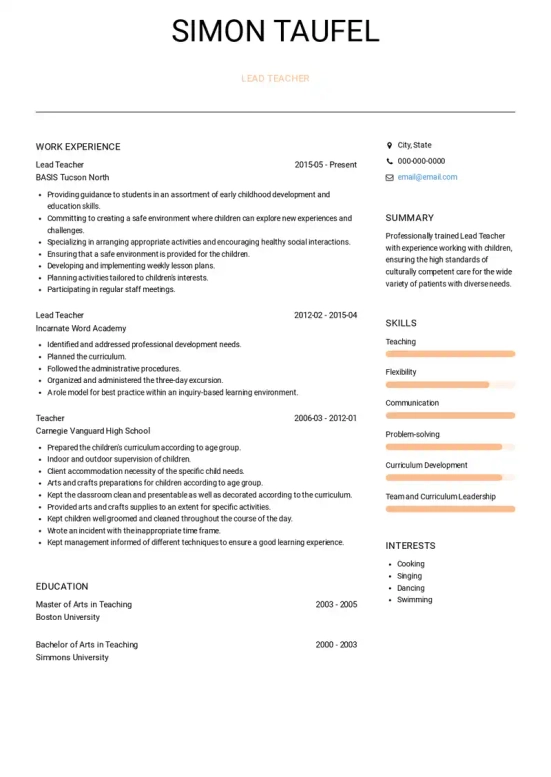
If you’ve ever written a resume before, you may already know about the reverse chronological resume format. It’s the most popular resume format out there, and it’s a classic for a reason. With a reverse chronological resume, you can prioritize your most recent work experience, giving hiring managers a clear sense of where you are in your career.
But what does a reverse chronological resume actually involve? Should you always rely on this tried and tested format, or are there times when it’s better to take another approach? And do you need a particular resume template to make the most of the reverse chronological approach?
If you’ve ever asked yourself any of these questions, look no further! We’ve put together a comprehensive guide to the reverse chronological resume format, so you can get the most out of it when it’s time to look for a job. Read on, and we’ll give you all the information you need to know!
On this page, we’ll cover the following points:
- What a reverse chronological resume actually is
- How to build your reverse chronological resume
- When to use the reverse chronological resume format
- Some of our favorite reverse chronological resume templates
What is a Reverse Chronological Resume?
A reverse chronological resume is a resume that organizes the work experience section in reverse chronological format. That means it lists your most recent work experience first—then works backwards, in the same order, through your work history.
If this sounds like the standard approach to writing a resume, that’s because it is! The reverse chronological resume format is by far the most popular way to arrange a resume. It isn’t the only way to do it, but it’s certainly common enough to be the default approach.
That’s because most employers consider recent work experience to be the most important factor they consider when hiring. A reverse chronological resume puts your most recent work experience at the forefront of your resume. It makes it easy for hiring managers to find what they’re looking for—and since most hiring managers are extremely short on time, that will give you a real advantage in its own right.
It’s also worth remembering that many companies use ATS (applicant tracking software) to sort qualified applicants from unqualified applicants. This happens right at the start of the hiring process, usually before a real person has even looked at your resume. Reverse chronological resumes are easy for ATS software to parse—meaning that a reverse chronological resume might give you an edge in getting through that crucial first stage.
The reverse chronological resume format is versatile, widely recognized, and easy for both humans and software to read and understand. Where other resume formats tend to have very specific applications, the reverse chronological format is a great approach to take in most circumstances. If you’re not sure which resume format to use, the odds are good that this format will work well for you!
How to Make a Reverse Chronological Resume
As you might expect, it’s simple to make a reverse chronological resume! You just need to make sure you have your approximate dates of employment in all your recent roles. That way, you’ll have a much easier time sorting them into the right order.
Like any resume, your reverse chronological resume should contain all of the following sections:
- Your name and contact information
- A resume summary (and objective, if you have limited prior experience)
- Your recent work experience
- Your education, including any certifications or licenses
- Your skills
These sections can, within reason, appear in any order. That said, it’s standard to feature your name and contact information and your resume summary at the very beginning of your resume. And unless you’re applying for your first job, your work experience will usually be the most important section of your resume—so after those two elements, your work experience should appear next.
When writing a reverse chronological work experience section, you need to list your recent roles in order, starting with the most recent and working backwards. When listing each role, you should include all of the following information:
- The name of the company where you worked
- Your job title
- Your employment dates (it’s usually fine to list the month and year when you started and the month and year when you finished)
- A bullet-pointed list of your most relevant achievements and responsibilities within the role
As always, you should tailor this section to the requirements of the job description for the role you want. If you need prior customer service experience to be considered for your new role, make sure you mention your prior customer service experience when writing about your recent employment! And wherever possible, you should try to quantify that experience with concrete, verifiable achievements—things like statistics, sales figures and performance indicators will make your resume much more credible.
You should also make sure that all of your employment history listings are formatted in the same way. That consistency will make for a more visually appealing resume, and will make sure you look as professional as possible. Choosing the right resume template can help you with that, and we’ll list some of our favorite reverse chronological resume templates later in this post.
How to Use a Reverse Chronological Resume
The reverse chronological resume can be a great asset in a range of job search situations. But when is it a particularly good idea to use this resume format? And most importantly, when should you consider using a different format instead?
The reverse chronological format is ideal in two particular situations:
- You have a consistent employment history, without any substantial gaps
- You have worked in the same industry (or similar industries) throughout your career
Reverse Chronological Resume and Career Gaps
Because a reverse chronological resume gives hiring managers a comprehensive overview of your career history, it doesn’t leave you anywhere to hide any gaps or career breaks. If you’ve taken an extended period of time off from work for any reason, this could put you at a slight disadvantage if you use the reverse chronological resume format.
It’s worth noting that that doesn’t have to be a dealbreaker! If you took a few years off to raise a child, care for a loved one, or pursue further education, you may be able to list that career break as part of your work history. That way, the gap in your work history will be accounted for right away, and won’t lead to any potentially awkward questions if you get to interview.
But if you’re worried about calling undue attention to a career gap, you may benefit from using a different resume format. A functional resume or combination resume format will give you more scope to gloss over a career break, since they are less focused on providing a chronological recounting of your work history.
Reverse Chronological Resume and Career Changes
Likewise, if you’re making a big career change, you may not want to focus so much on a reverse chronological listing of your work experience. That’s because your work experience may not be relevant to the job you actually want. In this case, a reverse chronological resume format might lure you into including a lot of information that may not matter much to a hiring manager!
In that situation, focusing on your skills will give hiring managers a clearer picture of what you’re capable of. A functional resume, which puts the spotlight on your skills and how you have applied them in the past, may give you a bigger advantage.
Best Industries for a Reverse Chronological Resume
We’ve talked about the situations when a reverse chronological resume may not work well for you. But what about the industries where it can particularly shine?
As we’ve discussed, reverse chronological resumes are widely-used and widely-understood. The only real circumstances in which a reverse chronological resume won’t work for you are the two we’ve explained above. That means that, provided you don’t have any career gaps you’d like to gloss over and you aren’t making a big career change, you can use a reverse chronological resume format in just about any industry.
But there are certain industries where a reverse chronological format can really shine. If you’re looking for work in a more conservative industry, where employers may be suspicious of a less conventional resume format, the reverse chronological format should be your first choice. In that situation, applying with a reverse chronological resume will show that you understand professional norms and standards—and most importantly, that you are prepared to adhere to them.
Here are some industries where a reverse chronological resume format will serve you especially well:
- Finance
- Sales
- Administration
- Manufacturing
- Pharmaceuticals
- Medicine
That’s not to say that you can’t use a reverse chronological resume in less traditional workplaces or industries! Creative fields like design, marketing and media will still understand and appreciate a reverse chronological resume. So will cutting-edge workplaces like start-ups and tech companies, which have a reputation for experimenting with new ideas before other companies follow suit.
But those companies may be more receptive to other resume formats than the industries listed above. When applying for a job in a more traditional industry, it’s smart to stick to what works—and that’s the reverse chronological resume.
What Type of Resume Offers a Reverse Chronological Order?
At VisualCV, we believe we offer some of the best resume templates on the internet. But which one should you choose for your reverse chronological resume?
The good news is that there’s no wrong answer here! All of our templates can be adapted to suit a reverse chronological resume order. What’s more, they’re all guaranteed to be ATS-compatible, so whichever template you choose will work seamlessly with ATS software regardless of its format.
To get you started in choosing the right template for you, we’ve listed some of our favorite resume templates below. Take a look and see which one you like best!
Arya
This streamlined, elegant template offers a great way to format your reverse chronological work history section. Pops of color call attention to your past employers and employment dates, so hiring managers can understand at a glance what they’re reading. It’s readable, visually engaging, and stylish enough to pass muster at any type of company—so wherever you take Arya, it will have your back.
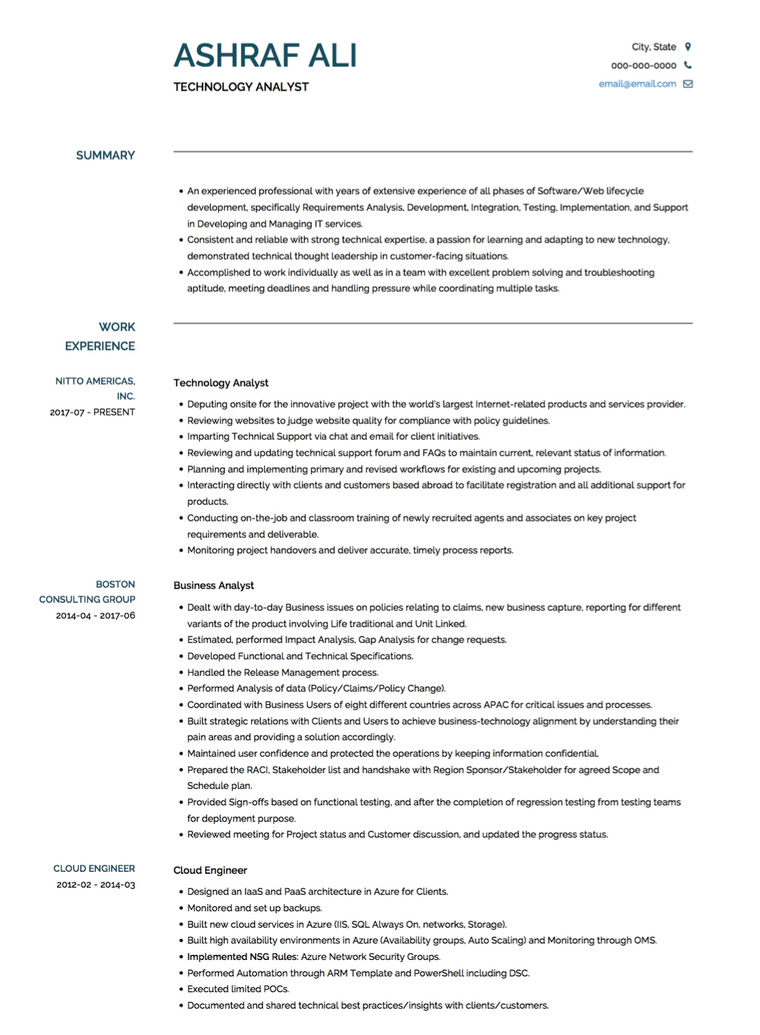
ATS
Are you applying for a company that could be put off by the bells and whistles of more creative resume templates? Or do you just want to be 100% confident that your resume will make it through an ATS software screening? The ATS resume template is simple, sleek and traditional in every sense—which makes it perfect for a reverse chronological resume format.
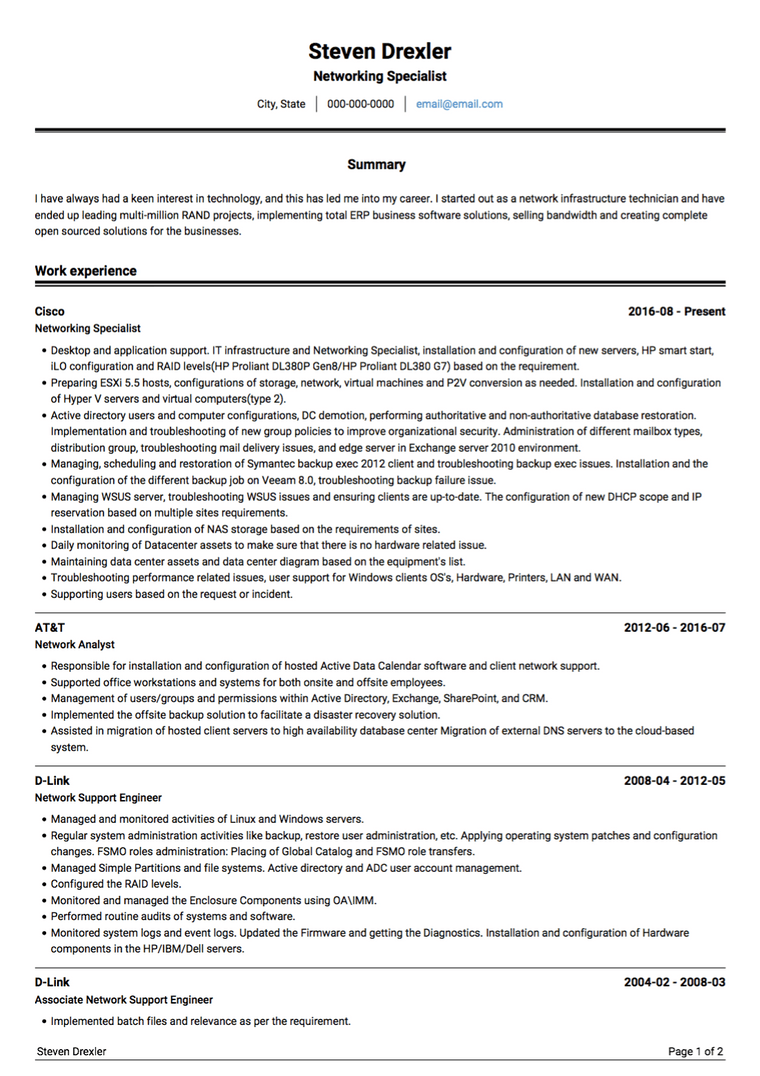
Corporate
The Corporate template is built for the world of business, featuring a streamlined two-column layout and classic, readable fonts. Within the work history section, it calls attention to the employment dates, so it’s easy for hiring managers to understand the reverse chronological format. If you’re applying for a job in a traditional industry and don’t want your resume to skew too creative in its design, this is the template for you.
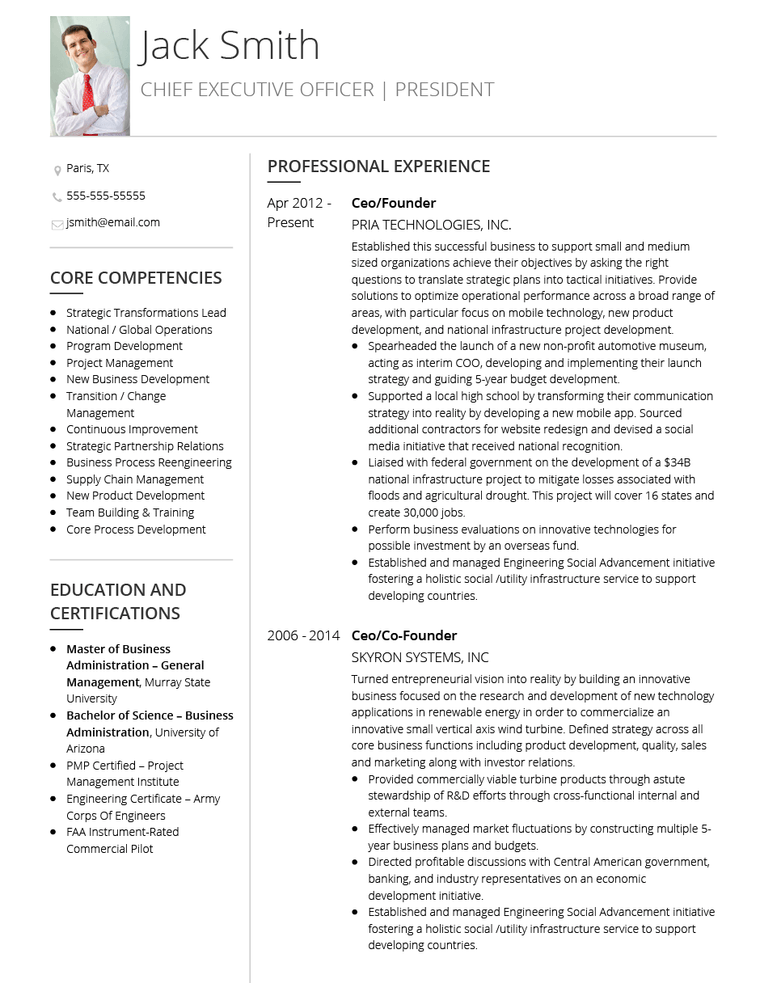
Monte
The Monte template offers the best of both worlds, striking an elegant compromise between its traditional layout and its more creative font and color choices. It’s designed for a reverse chronological format, with employment and education dates set apart for ease of reading. For applicants looking to add a touch of personality to a classic resume format, this template is the way to go.
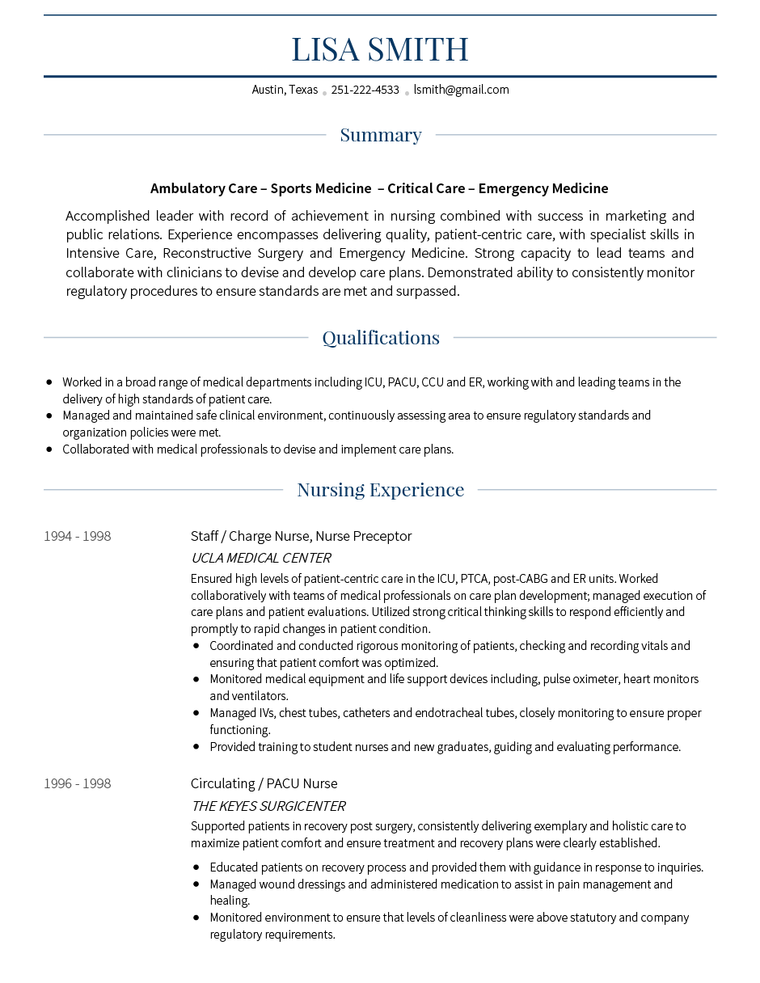
Vida
This two-column resume template uses pops of color smartly, calling attention to key details like employment dates throughout. While its formatting choices are bold and eye-catching, it uses them sparingly enough to avoid seeming unprofessional or chaotic. This template is particularly great for candidates looking for a one-page resume—the two-column layout allows you to fit more information onto a page, without ever compromising on style.
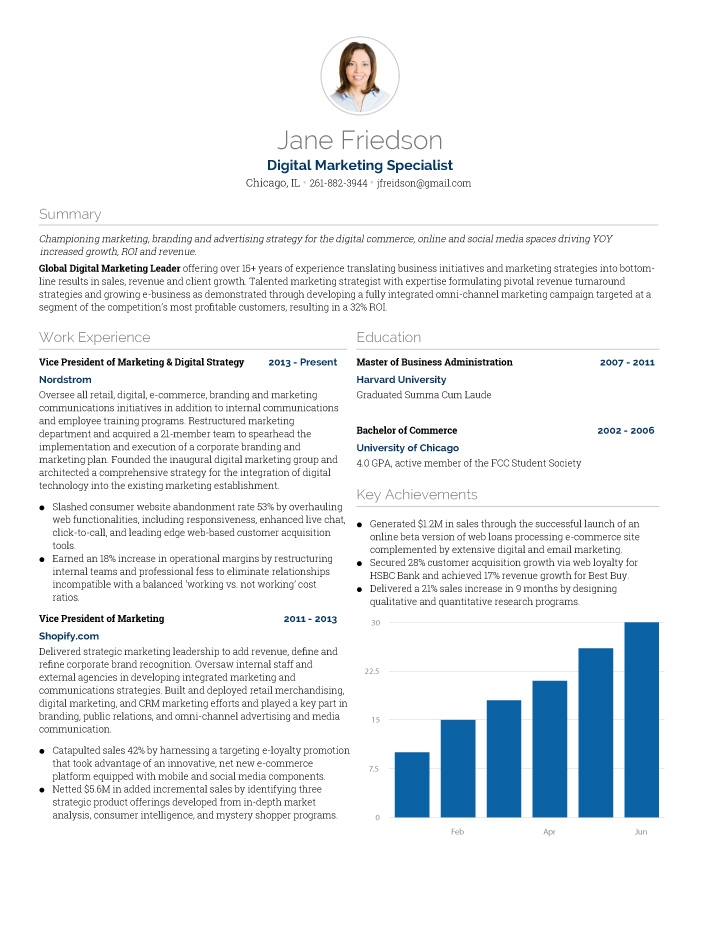
Copyright ©2025 Workstory Inc.